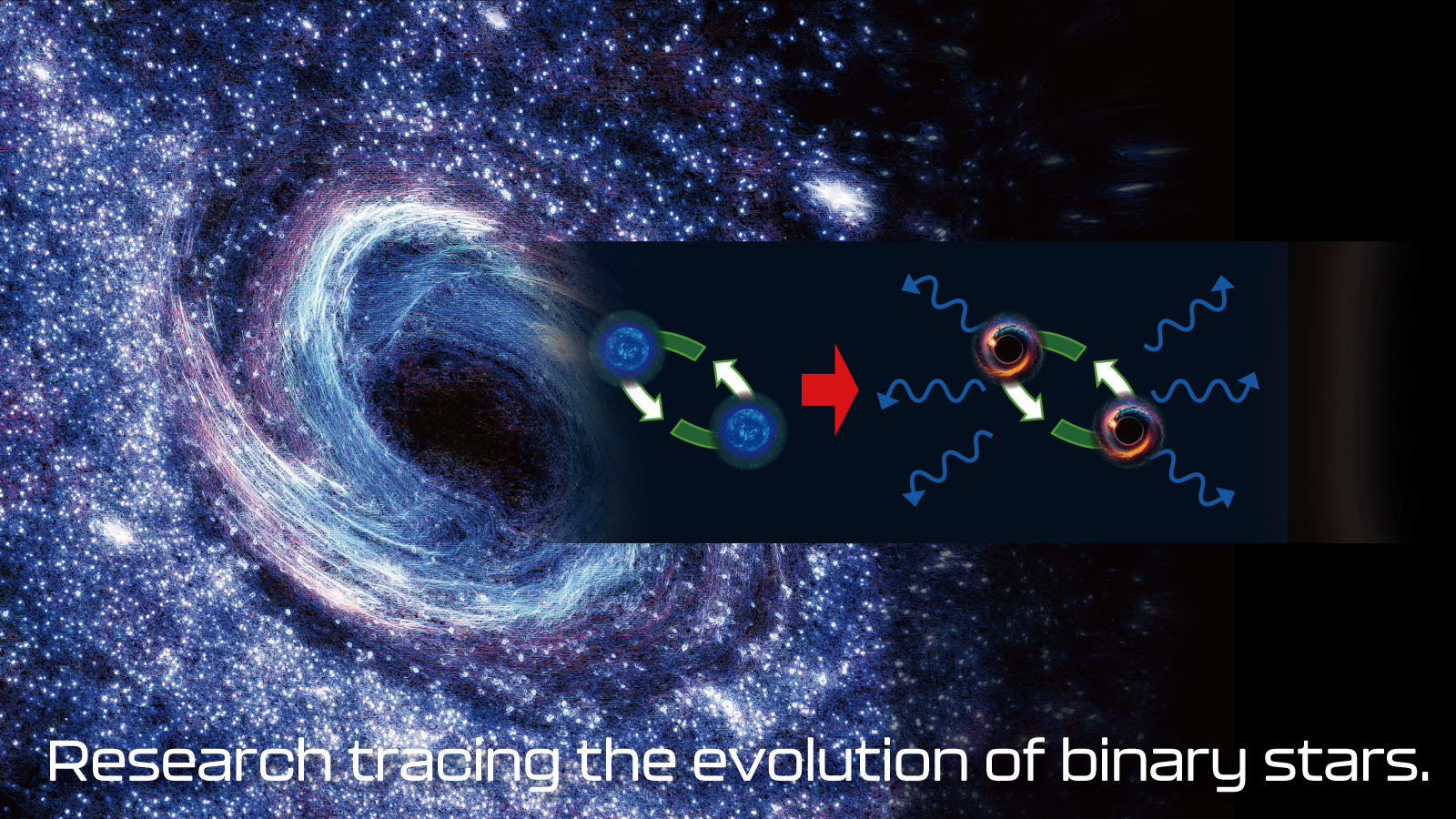Natural Sciences, Social Sciences, and Humanities
Release date:February 7, 2025 11:33 AM
Faculty of EngineeringFate of supernova progenitors in massive binary systems

How massive stars end their lives depends on the core mass, core angular momentum, and hydrogen envelopes at death. However, these key physical facets of stellar evolution can be severely affected by binary interactions. In turn, the effectiveness of binary interactions itself varies greatly depending on the initial conditions of the binaries, making the situation much more complex. We investigate systematically how binary interactions influence core–collapse progenitors and their fates. Binary evolution simulations are performed to survey the parameter space of supernova progenitors in solar metallicity binary systems and to delineate major evolutionary paths. We first study fixed binary mass ratios (= 0.5, 0.7, and 0.9) to elucidate the impacts of initial mass and initial separation on the outcomes, treating separately Type Ibc supernova, Type II supernova, accretion-induced collapse (AIC), rapidly rotating supernova (Ibc-R), black hole formation, and long gamma ray burst (long GRB). We then conduct 12 binary population synthesis model calculations, varying the initial condition distributions and binary evolution parameters, to estimate various supernova fractions. We obtain a Milky Way supernova rate which is consistent with observations. We find the rates of AIC, Ibc-R, and long GRB to be the rate of regular supernovae. Our estimated long GRB rates are higher than the observed long GRB rate and close to the low luminosity GRB rate, although care must be taken considering our models are computed with solar metallicity. Furthering binary modelling and improving the inputs one by one will enable more detailed studies of these and other transients associated with massive stars.
1 INTRODUCTION
Stellar evolution holds paramount importance in astrophysics, providing a foundational framework for not only comprehending the behaviours of stars but also their profound influence on shaping the Universe. By studying how stars form, evolve, and eventually die, one can gain insights into a wide range of astrophysical phenomena, from the properties of individual stars to the formation and evolution of galaxies (Conroy 2013; Nomoto, Kobayashi & Tominaga 2013; Smith 2014; Eldridge & Stanway 2022). In particular, supernovae (SNe) and long gamma-ray bursts (long GRBs) are among the most powerful and intriguing transient phenomenon in the Universe, which are the explosions triggered by the death of massive stars (Woosley, Heger & Weaver 2002; Woosley & Bloom 2006; Gehrels, Ramirez-Ruiz & Fox 2009; Smartt 2009).
In a seminal work on stellar evolution, Heger et al. (2003) illustrated that a star’s mass and metallicity determine its eventual fate (see also Woosley, Langer & Weaver 1995; Woosley et al. 2002; Woosley & Heger 2007; Sukhbold et al. 2016, for systematic studties). A variety of models are provided and they are often used in SN modelling (Umeda & Nomoto 2008; Umeda, Yoshida & Takahashi 2012; Sukhbold, Woosley & Heger 2018; Chieffi & Limongi 2020). With the ever-increasing power of supercomputers, studies of the systematic effects of the progenitor mass and metallicity have been explored in multidimensional numerical simulations of massive star collapse (Nakamura et al. 2015; Summa et al. 2016; Burrows et al. 2020; Vartanyan & Burrows 2023). Among the many insights they have provided, of particular importance is that the anisotropy of the Si/O shell is enough to alter the course of dynamical evolution of the core–collapse SN (Bollig et al. 2021). Thus, 3D simulations have been performed with limited time-scale of the Si/O burning phase to explore more realistic profiles of the progenitors (Couch et al. 2015; Müller et al. 2016b; Mocák et al. 2018; Yoshida et al. 2019; Yadav et al. 2020; Yoshida et al. 2021b).
2 INTRODUCTION
One commonly missing ingredient in previous studies of SN progenitors is rotation. This is despite the fact that massive stars initially have high angular momentum (Wolff et al. 2006; Huang, Gies & McSwain 2010) and rotation affects the evolution of stars as strongly as mass and metallicity (e.g. Maeder 2009); for example, centrifugal force, angular momentum transport, and rotation-induced mixing change the stellar structure (see Langer 2012, and the refereces therein). Several evolutionary models have incorporated the impact of rotation (Heger, Langer & Woosley 2000; Heger, Woosley & Spruit 2005; Ekström et al. 2012; Georgy et al. 2012). Yoon, Langer & Norman (2006) have helped us to delineate the fate of the massive stars in the parameter space of mass, metallicity, and rotation. At the extreme, a star can completely change its evolution when it undergoes chemically homogeneous evolution (CHE) due to efficient mixing induced by rotation (Woosley & Heger 2006; Yoon et al. 2006; Aguilera-Dena et al. 2018). Although CHE may not be common, more generally stars are deformed by rotation; axisymmetric equilibrium structures of rotating stars in two spatial dimensions have been obtained (see Ogata et al. 2023, and the refereces therein). It is imperative to also acknowledge the intricate connection of magnetic fields and rotation in stellar evolution (see Keszthelyi 2023, and refereces therein). A way to handle the shape of the magnetic fields was recently developed (Takahashi & Langer 2021). The effect of rotation and magnetic fields are eagerly studied by 3D simulations in the phases right before the core collapse (Varma & Müller 2021; Yoshida et al. 2021a; Fields 2022; McNeill & Müller 2022). The strength of the magnetic field and rotation of stellar cores are thought to even dictate the outcome of explosion, including explosion energies and morphologies, as well as occurrence of SNe versus long GRBs (e.g. Iwakami, Nagakura & Yamada 2014; Summa et al. 2018; Kuroda et al. 2020; Takiwaki, Kotake & Foglizzo 2021; Matsumoto et al. 2022; Obergaulinger & Aloy 2022; Bugli et al. 2023; Hsieh et al. 2024; Shibagaki et al. 2024; Varma, Müller & Schneider 2023).
3 INTRODUCTION
One commonly missing ingredient in previous studies of SN progenitors is rotation. This is despite the fact that massive stars initially have high angular momentum (Wolff et al. 2006; Huang, Gies & McSwain 2010) and rotation affects the evolution of stars as strongly as mass and metallicity (e.g. Maeder 2009); for example, centrifugal force, angular momentum transport, and rotation-induced mixing change the stellar structure (see Langer 2012, and the refereces therein). Several evolutionary models have incorporated the impact of rotation (Heger, Langer & Woosley 2000; Heger, Woosley & Spruit 2005; Ekström et al. 2012; Georgy et al. 2012). Yoon, Langer & Norman (2006) have helped us to delineate the fate of the massive stars in the parameter space of mass, metallicity, and rotation. At the extreme, a star can completely change its evolution when it undergoes chemically homogeneous evolution (CHE) due to efficient mixing induced by rotation (Woosley & Heger 2006; Yoon et al. 2006; Aguilera-Dena et al. 2018). Although CHE may not be common, more generally stars are deformed by rotation; axisymmetric equilibrium structures of rotating stars in two spatial dimensions have been obtained (see Ogata et al. 2023, and the refereces therein). It is imperative to also acknowledge the intricate connection of magnetic fields and rotation in stellar evolution (see Keszthelyi 2023, and refereces therein). A way to handle the shape of the magnetic fields was recently developed (Takahashi & Langer 2021). The effect of rotation and magnetic fields are eagerly studied by 3D simulations in the phases right before the core collapse (Varma & Müller 2021; Yoshida et al. 2021a; Fields 2022; McNeill & Müller 2022). The strength of the magnetic field and rotation of stellar cores are thought to even dictate the outcome of explosion, including explosion energies and morphologies, as well as occurrence of SNe versus long GRBs (e.g. Iwakami, Nagakura & Yamada 2014; Summa et al. 2018; Kuroda et al. 2020; Takiwaki, Kotake & Foglizzo 2021; Matsumoto et al. 2022; Obergaulinger & Aloy 2022; Bugli et al. 2023; Hsieh et al. 2024; Shibagaki et al. 2024; Varma, Müller & Schneider 2023).
Point
If the Roche lobe around a star is fulfilled, the material of the stellar surface is transferred to its companion through the L1 point. The Roche lobe radius of the donor star is approximately described as (Eggleton 1983)
where β is the accretion parameter of the mass transfer. On the other hand, strongly depends on the evolutionary stage of the donor star. When the donor star is in the red giant phase, is described as
When the donor star is in other evolutionary phases, is 2.59, 6.85, 1.95, and 5.79 for the main sequence phase, the Hertzsprung gap phase (Hjellming 1989), the naked-He main sequence phase and the naked-He giant star (Ivanova et al. 2003; Belczynski et al. 2008), respectively.
Keyword
- ※1 Merged remnant and rotation effect
where and are the mass and the radius of the CO core,
- ※2 MODELS AND CALCULATION RESULTS
where and are the mass and the radius of the CO core, and is the radius of the star just before SN. We estimate using the fitting formula,
- ※3 There are two parameter regions corresponding to an AIC
where and are the mass and the radius of the CO core, and is the radius of the star just before SN. We estimate using the fitting formula,
- ※4 Common envelope
If the companion star plunges into the primary star which has a core and envelope structure due to an eccentric orbit, or mass transfer becomes dynamically unstable
Paper
Magazine Name:Monthly Notices of the Royal Astronomical Society(532(4), 3926–3946, 2024)
Paper Title:Fate of supernova progenitors in massive binary systems
Author:Tomoya Kinugawa, Shunsaku Horiuchi, Tomoya Takiwaki, Kei Kotake
Related Topics
Related Topics
